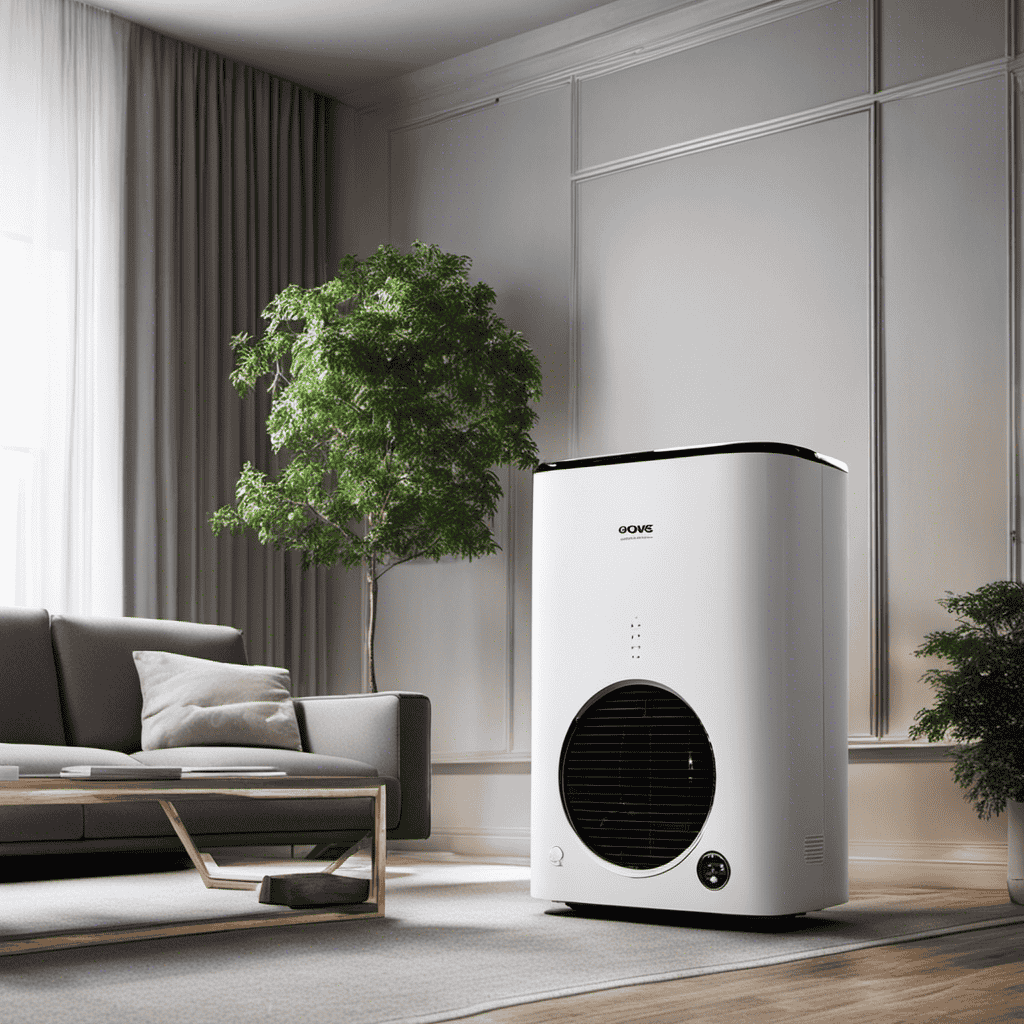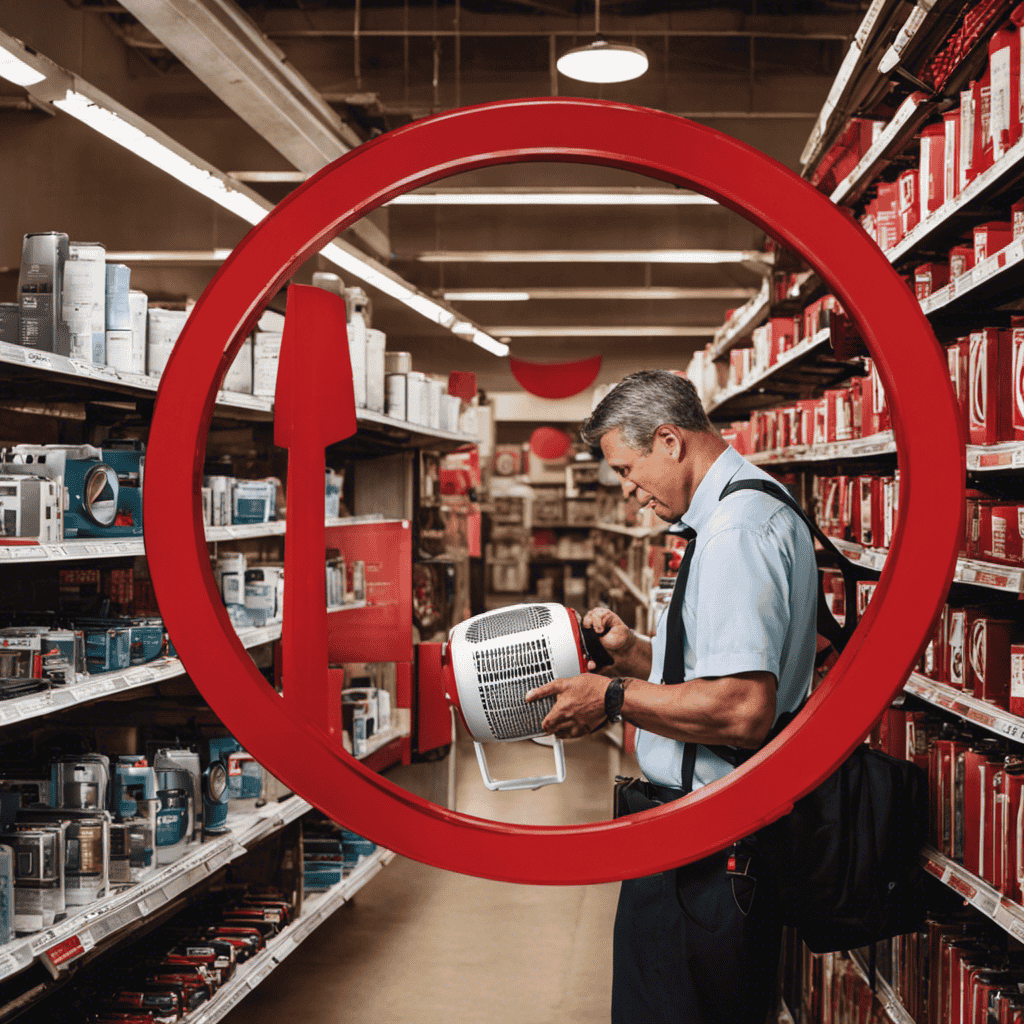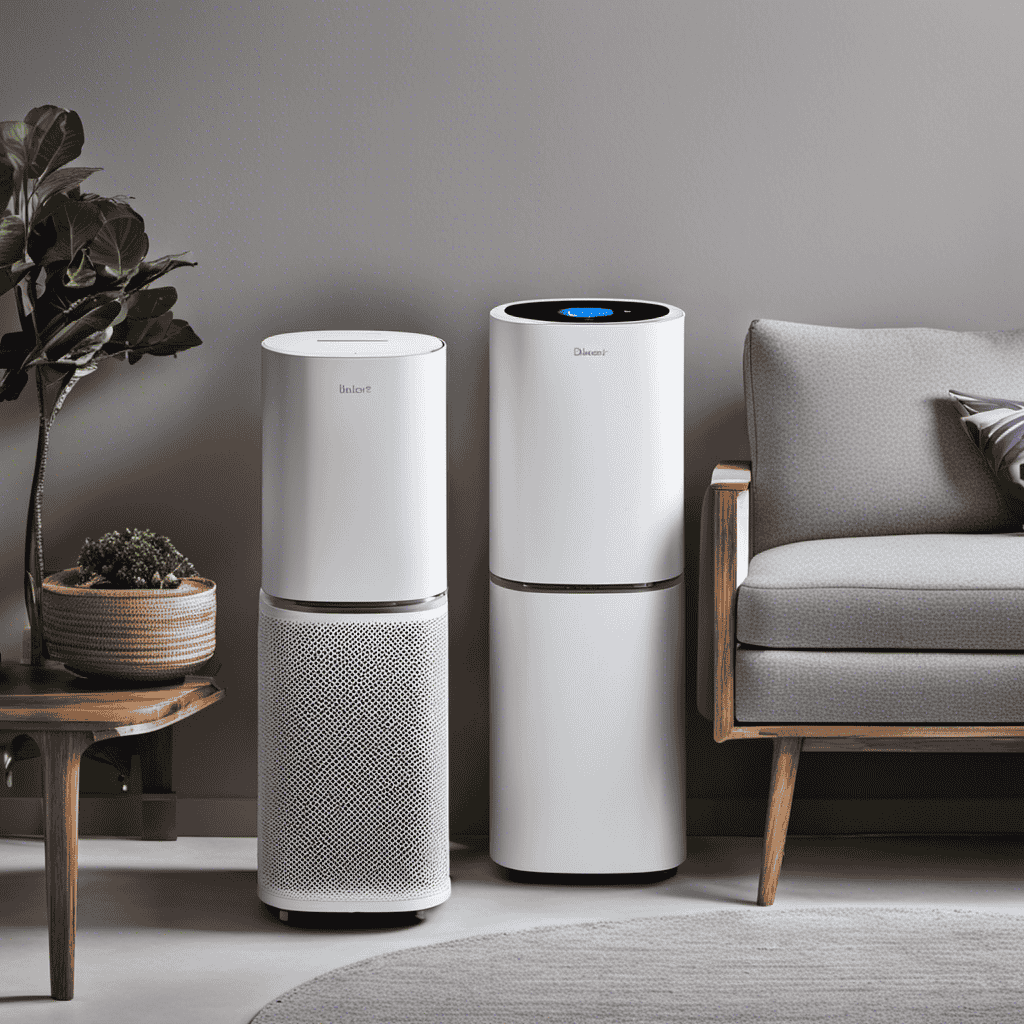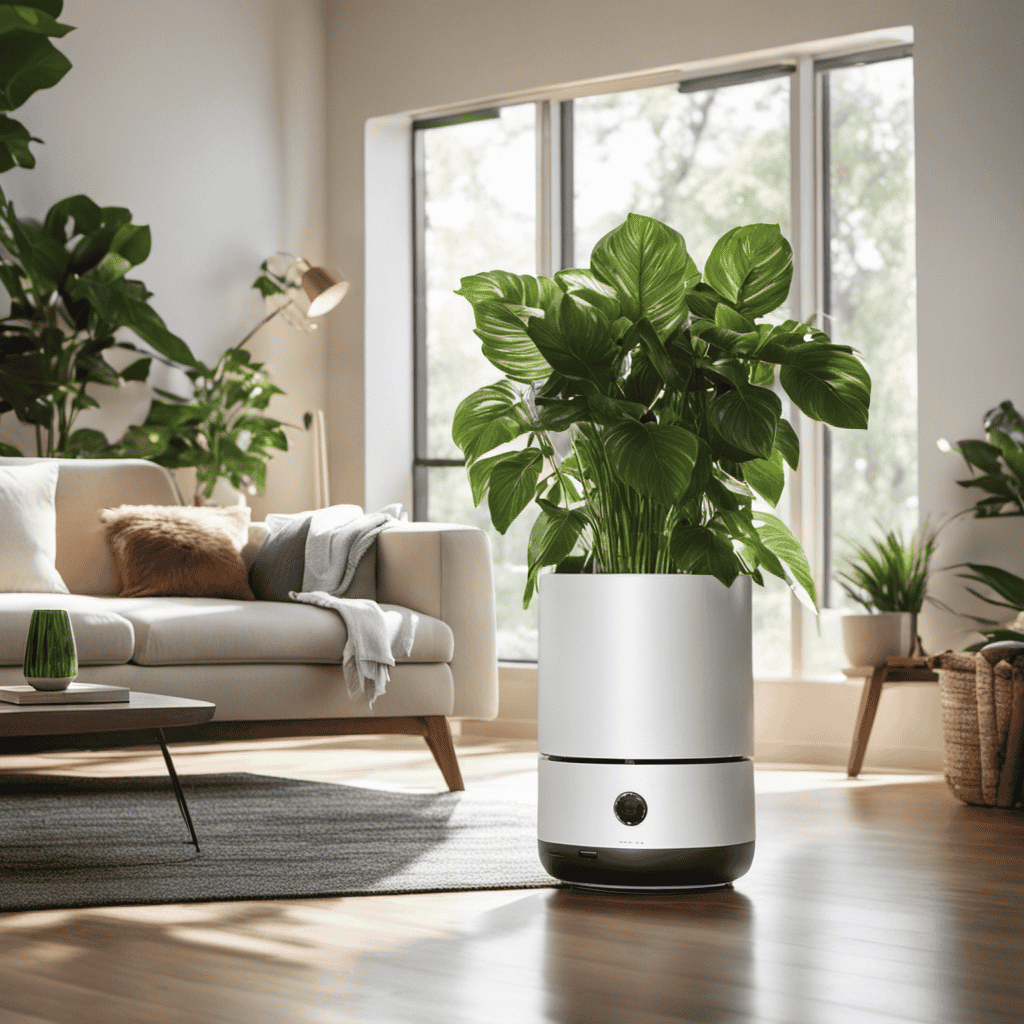I’ve always been curious about the functioning of ozone air purifiers, so I decided to do a bit of digging.
Did you know that indoor air pollution can be up to five times worse than outdoor air pollution? That’s a startling statistic that highlights the importance of finding effective methods to purify the air in our homes.
In this article, I’ll explain the science behind ozone air purifiers and how they break down pollutants to provide cleaner and healthier air.
Let’s dive in and explore how ozone air purifiers work.
Key Takeaways
- Ozone air purifiers produce ozone molecules (O3) through corona discharge or ultraviolet light.
- Ozone is highly reactive and can destroy bacteria, viruses, mold, and VOCs.
- Ozone air purifiers should be used with caution due to potential harmful effects on human health.
- Proper ventilation is crucial when using ozone air purifiers to minimize negative impacts.
Understanding Ozone: What Is It and How Does It Work
Ozone is a gas that’s formed when oxygen molecules are exposed to electrical charges, and it works by neutralizing odors and killing bacteria and viruses.
When it comes to the environment, ozone has both positive and negative effects. In the upper atmosphere, ozone acts as a protective shield, absorbing harmful ultraviolet (UV) radiation from the sun. However, at ground level, ozone can be harmful to human health and the environment.
In indoor air quality, ozone generators are sometimes used as air purifiers. These devices produce ozone to eliminate unpleasant odors and remove airborne pollutants. However, it’s important to note that ozone generators can also produce harmful byproducts and should be used with caution.
Proper ventilation is crucial to minimize the potential negative impact of ozone on indoor air quality.
The Science Behind Ozone Air Purifiers: Explained
To understand how an ozone air purifier operates, you need to grasp the underlying science behind it. Ozone air purifiers use ozone technology to clean the air by neutralizing pollutants and odors. Here are three key points to help you understand the science behind ozone air purifiers:
-
Ozone generation: Ozone air purifiers produce ozone molecules (O3) by using either corona discharge or ultraviolet light. These methods break down oxygen molecules (O2) into individual oxygen atoms, which then combine with other oxygen molecules to form ozone.
-
Ozone’s impact: Ozone is a highly reactive gas that can react with and destroy various pollutants, such as bacteria, viruses, mold, and volatile organic compounds (VOCs). It can also eliminate strong odors by oxidizing the organic compounds responsible for the smell.
-
Safety precautions: While ozone air purifiers can be effective in improving indoor air quality, it’s essential to use them properly. High levels of ozone can be harmful to humans, causing respiratory irritation and other health issues. Therefore, it’s crucial to follow the manufacturer’s instructions and use ozone air purifiers in unoccupied spaces or with proper ventilation.
Understanding the science behind ozone air purifiers can help you make informed decisions about improving your indoor air quality.
Ozone Generation: How Is Ozone Produced in Air Purifiers
Using either corona discharge or ultraviolet light, ozone air purifiers break down oxygen molecules into individual oxygen atoms, which then combine with other oxygen molecules to form ozone. Ozone generation in air purifiers requires certain safety precautions to prevent any harm to individuals.
It is important to ensure proper ventilation and control the concentration of ozone produced. Ozone air purifiers have an impact on indoor air quality by effectively neutralizing odors, killing bacteria, and eliminating allergens. However, it is crucial to note that excessive ozone levels can be harmful to human health.
It is recommended to follow manufacturer guidelines and use ozone air purifiers in a controlled manner. Understanding the process of ozone generation and its impact on indoor air quality is essential for maintaining a safe and healthy environment.
In the subsequent section, we will explore ozone’s role in air purification by breaking down pollutants.
Ozone’s Role in Air Purification: Breaking Down Pollutants
When it comes to air purification, ozone plays a crucial role in breaking down pollutants.
Ozone’s purification mechanism involves the process of oxidation, where ozone molecules react with pollutants, such as bacteria, viruses, and odors, through a chemical reaction.
This reaction helps to neutralize and eliminate these harmful substances, resulting in cleaner and fresher air.
Ozone’s Purification Mechanism
Understanding how an ozone air purifier works is important for you to fully grasp its purification mechanism. Ozone, a highly reactive form of oxygen, plays a crucial role in the air purification process. Here are three key aspects of ozone’s impact and benefits in air purification:
-
Oxidation: Ozone acts as a powerful oxidant, breaking down and neutralizing various pollutants in the air. It targets harmful substances like bacteria, viruses, mold, and volatile organic compounds (VOCs), transforming them into harmless byproducts through oxidation.
-
Dissipation: Ozone is not a long-lasting gas and quickly dissipates into oxygen molecules. This ensures that the purified air remains safe and free from any residual ozone.
-
Odor Elimination: Ozone has a distinct smell and is effective in eliminating unpleasant odors caused by smoke, pet dander, or cooking fumes. It neutralizes the odor-causing molecules, leaving behind fresh and clean air.
Ozone’s Pollutant Breakdown?
To fully appreciate how an ozone air purifier breaks down pollutants, you should be aware of its powerful oxidizing properties and its ability to neutralize harmful substances in the air.
Ozone, a molecule composed of three oxygen atoms, is highly reactive and can oxidize pollutants by releasing an oxygen atom. This process breaks down the pollutants into harmless compounds. It can eliminate odors, kill bacteria, and destroy volatile organic compounds (VOCs).
However, it is important to note that while ozone air purifiers can be effective in removing certain pollutants, they also have potential environmental concerns. Ozone, when released into the atmosphere, can contribute to the formation of smog and may have adverse effects on human health.
Therefore, it is crucial to use ozone air purifiers responsibly and follow manufacturer guidelines to minimize ozone’s impact and address environmental concerns.
Ozone Vs. Traditional Filters: a Comparison of Air Purification Methods
In comparing ozone air purifiers to traditional filters, it is important to consider the effectiveness of ozone as an air purification method. While ozone has been touted for its ability to break down pollutants, its effectiveness in actually removing these pollutants from the air has been questioned by experts.
Additionally, there are safety concerns associated with ozone, as it can be harmful to humans and pets when present in high concentrations. On the other hand, traditional filters have been proven to effectively remove pollutants from the air and provide a safer and more reliable method of air purification.
Ozone Effectiveness Questioned
You should be aware that the effectiveness of ozone air purifiers has been questioned by experts. While these devices claim to clean the air by producing ozone, there are concerns about their safety and efficacy. Here are three important points to consider:
-
Ozone safety concerns: Ozone is a highly reactive gas that can be harmful to human health when present in high concentrations. Prolonged exposure to ozone can irritate the respiratory system, leading to coughing, chest pain, and shortness of breath. It can also worsen existing respiratory conditions such as asthma.
-
Ozone air purifier effectiveness: Some studies suggest that ozone air purifiers may not effectively remove pollutants from the air. While ozone can react with certain pollutants and neutralize them, it may not be able to completely eliminate all types of contaminants. Furthermore, the production of ozone can create harmful byproducts that can be detrimental to indoor air quality.
-
Expert opinions: Many experts, including the Environmental Protection Agency (EPA), caution against the use of ozone air purifiers. They recommend using alternative air purification methods, such as HEPA filters, which have been proven to be more effective and safer for indoor air quality.
Considering these concerns, it is important to thoroughly research and understand the potential risks associated with ozone air purifiers before making a decision.
Safety Concerns With Ozone
After discussing the effectiveness of ozone air purifiers in the previous section, it’s important to address some safety concerns associated with these devices.
One major concern is the potential harm they may cause to indoor plants. Ozone can damage plant tissues and inhibit their ability to photosynthesize, ultimately leading to their decline or death. Therefore, if you have a lot of indoor plants, it’s advisable to avoid using ozone air purifiers.
Another safety concern is the effect of ozone on pet dander. While ozone may help eliminate odors and reduce allergens in the air, it can also react with pet dander particles and create harmful byproducts. These byproducts can irritate the respiratory system of both humans and pets, potentially leading to health issues. If you have pets at home, it’s crucial to consider this risk before using ozone air purifiers.
Benefits of Traditional Filters
If you’re looking for a safer alternative, traditional filters can effectively remove contaminants from the air without the potential risks associated with ozone air purifiers. Traditional filters are a popular choice when it comes to improving indoor air quality and have several benefits over ozone air purifiers.
Here are three reasons why traditional filters are a better option:
-
Safe and reliable: Unlike ozone purifiers, traditional filters do not emit any harmful byproducts. They work by physically trapping particles and pollutants in the air, ensuring that only clean air is released back into your living space.
-
Versatile: Traditional filters can remove a wide range of contaminants, including dust, pollen, pet dander, mold spores, and even some bacteria and viruses. They are effective in improving the overall air quality and reducing allergy symptoms.
-
Low maintenance: Traditional filters are easy to maintain and require minimal effort. Most filters can be easily replaced or cleaned, ensuring that your air purifier continues to work efficiently.
Safety Concerns: Addressing the Potential Risks of Ozone Air Purifiers
Addressing the potential risks of ozone air purifiers is important. It’s crucial to understand how they work and the safety concerns they may pose. Ozone air purifiers emit ozone gas, which is intended to eliminate odors and kill bacteria and viruses in the air. However, these devices can also produce harmful by-products, such as nitrogen oxides and formaldehyde. These by-products can lead to potential side effects like respiratory irritation, coughing, and wheezing. The Environmental Protection Agency (EPA) has set ozone exposure limits to protect public health. They recommend a limit of 0.05 parts per million (ppm) for an 8-hour average exposure. It’s crucial to be aware of these limits and ensure that ozone air purifiers are used in a well-ventilated space. This will help minimize the risks associated with ozone exposure.
Ozone Air Purifiers and Allergens: Can They Effectively Remove Allergens
When it comes to the battle between ozone air purifiers and allergens, there are several key points to consider.
First, the effectiveness of ozone air purifiers in removing allergens is a subject of debate. While some studies suggest that ozone can help eliminate allergens, others caution about the potential health risks associated with high levels of ozone exposure.
As a result, it’s important to explore alternative allergy solutions that are both effective and safe.
Ozone Vs. Allergens: Effectiveness
The effectiveness of an ozone air purifier in reducing allergens has been widely debated. While ozone air purifiers claim to remove allergens from the air, there are several factors to consider when comparing ozone and HEPA air purification methods.
-
Ozone vs. HEPA: Ozone air purifiers work by releasing ozone molecules into the air, which react with pollutants and allergens. HEPA filters, on the other hand, physically trap allergens and pollutants in the filter, preventing them from circulating in the air.
-
Effectiveness and Safety: Ozone air purifiers may be less effective than HEPA filters in removing allergens. Furthermore, ozone can be harmful to individuals with asthma, as it can irritate the airways and worsen symptoms.
-
Potential Health Risks: Ozone air purifiers can generate ozone levels that exceed safety standards set by the Environmental Protection Agency. Prolonged exposure to high levels of ozone can lead to respiratory issues and other health problems.
Considering the potential health risks and the comparative effectiveness of ozone air purifiers, it is important to carefully evaluate their use in reducing allergens.
Potential Health Risks
One must consider the potential health risks associated with ozone air purifiers. While these devices are marketed as effective in removing odors and purifying the air, they emit ozone, a gas that can have harmful effects on human health. Ozone is a known respiratory irritant and can cause symptoms such as coughing, chest tightness, and shortness of breath. Long-term exposure to high levels of ozone can lead to more severe respiratory issues and may worsen existing conditions like asthma and allergies. It’s important to note that the ozone levels produced by these air purifiers can exceed the safety standards set by regulatory agencies. Therefore, it is crucial to weigh the potential side effects before using ozone air purifiers, especially in enclosed spaces with limited ventilation.
| Potential Side Effects | Long-term Exposure |
|---|---|
| – Respiratory irritation | – Worsening of asthma and allergies |
| – Coughing | – Increased risk of respiratory issues |
| – Chest tightness | – Exceeding safety standards |
| – Shortness of breath | – Limited ventilation in enclosed spaces |
Alternative Allergy Solutions?
Have you considered trying alternative solutions to manage your allergies? While traditional allergy medications can be effective, some people prefer to explore natural remedies and alternative allergy treatments. Here are three options worth considering:
-
Acupuncture: This ancient Chinese practice involves inserting thin needles into specific points on the body. It is believed to stimulate the body’s natural healing processes and help alleviate allergy symptoms. Some studies have shown promising results in reducing allergic rhinitis symptoms.
-
Herbal Supplements: Certain herbs, such as butterbur, stinging nettle, and quercetin, have been used for centuries to relieve allergy symptoms. These supplements may have anti-inflammatory and antihistamine properties, providing relief from sneezing, itching, and congestion.
-
Probiotics: Gut health plays a crucial role in the immune system, so improving your gut microbiome with probiotics may help reduce allergy symptoms. Some studies suggest that certain strains of probiotics can modulate immune responses and reduce inflammation.
It’s important to note that while these alternative treatments may provide relief for some individuals, they may not work for everyone. It is always recommended to consult with a healthcare professional before trying any new treatment.
The Odor Elimination Power of Ozone: How Does It Work
Ozone air purifiers work by producing ozone molecules that break down and eliminate odors. These purifiers are equipped with special filters that generate ozone through a process called corona discharge.
Ozone, a highly reactive form of oxygen, attaches to the odor molecules, breaking them down and neutralizing their smell. This technique is effective in eliminating a wide range of odors, including those caused by pets, cooking, and smoke.
One of the benefits of using ozone air purifiers for odor elimination is their ability to reach and eliminate odors in hard-to-reach places, such as carpets, upholstery, and fabrics.
Additionally, ozone air purifiers are known for their ability to freshen and purify the air, making them a popular choice for those seeking a cleaner and odor-free environment.
Ozone Air Purifiers and Bacteria/Viruses: Can They Kill Germs
To effectively kill germs, you need to ensure that your ozone air purifier is equipped with special filters designed to neutralize bacteria and viruses. Ozone air purifiers have been touted as effective tools in improving indoor air quality. But can they really kill germs and prevent mold growth? Let’s find out:
-
Ozone air purifiers can help reduce the presence of mold spores in the air. Mold spores are a common allergen and can cause respiratory issues. By neutralizing them, ozone air purifiers can potentially prevent mold growth.
-
However, it’s important to note that ozone air purifiers should not be solely relied upon for mold prevention. Proper ventilation and humidity control are also crucial in preventing mold growth.
-
When it comes to killing germs, ozone air purifiers can be effective. Ozone has been shown to have germicidal properties, capable of neutralizing bacteria and viruses in the air. However, it’s important to follow manufacturer guidelines and ensure that the ozone levels are within safe limits.
Maintenance and Care: Tips for Using and Maintaining Ozone Air Purifiers
You should regularly clean the filters of your ozone air purifier to ensure its effectiveness in maintaining indoor air quality. Proper maintenance is essential for the optimal performance of your air purifier.
One of the most common problems with ozone air purifiers is dirty filters, which can hinder the purification process and reduce the overall efficiency of the device. Cleaning the filters regularly helps remove dust, pollen, and other particles, ensuring that the purifier can effectively remove contaminants from the air.
Additionally, it is important to check and clean the ozone plates or electrodes in the purifier. Over time, these plates can accumulate residue, which can affect the production of ozone.
Choosing the Right Ozone Air Purifier: Factors to Consider Before Purchasing
Now that we’ve discussed how to properly maintain and care for an ozone air purifier, let’s move on to the next step: choosing the right one for your needs.
There are several factors to consider before purchasing an ozone air purifier.
-
Room size: The size of the room you want to purify is an important factor to consider. Make sure to choose a purifier that is suitable for the square footage of the room.
-
Ozone output: Different ozone air purifiers have varying ozone output levels. It’s important to choose one that produces the right amount of ozone for your specific needs.
-
Noise level: Some ozone air purifiers can be quite noisy, especially at higher settings. Consider the noise level and choose a purifier that won’t disturb your daily activities.
Pros:
- Effective in removing odors and bacteria
- Can improve air quality by reducing allergens
- Low maintenance and cost-effective in the long run
Cons:
- Ozone can be harmful if inhaled in large amounts
- Not suitable for constant use in occupied spaces
- Some people may be sensitive to ozone and experience respiratory issues.
Is an Ozone Free Air Purifier as Effective as an Ozone Air Purifier?
When it comes to air purifiers, the benefits of ozone free purifiers are undeniable. While ozone air purifiers may effectively eliminate odors and kill bacteria, they can also release ozone, which is harmful to breathe. Ozone free air purifiers are just as effective at removing pollutants without the potential health risks.
Conclusion
In conclusion, ozone air purifiers are a powerful and effective way to improve indoor air quality. By utilizing ozone generation, these purifiers can break down pollutants and eliminate odors, providing a fresh and clean environment.
While they can kill some bacteria and viruses, it’s important to note that they are not a substitute for proper hygiene practices.
When considering purchasing an ozone air purifier, factors such as room size and maintenance requirements should be taken into account.
So, why wait? Take a breath of fresh air with an ozone air purifier today!










